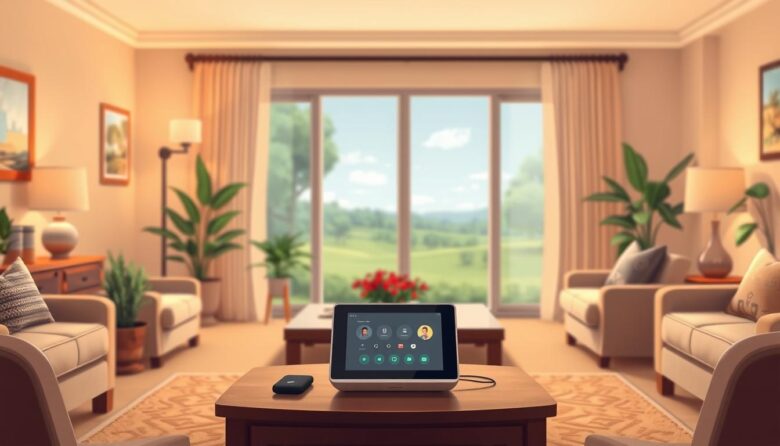Staying connected with loved ones has never been more important. After the pandemic, visual communication became a lifeline for families separated by distance. But for older adults, navigating complex technology can feel overwhelming. Many struggle with small buttons, confusing menus, or notifications that pop up unexpectedly.
Traditional devices like smartphones often create frustration instead of connection. Popular platforms like Zoom or FaceTime require multiple steps just to start a conversation. For those with memory challenges or limited tech experience, these hurdles can feel impossible to overcome.
That’s where specialized tools shine. Simplified interfaces remove distractions and focus on what matters: seeing familiar faces. Large icons, automatic answers, and one-touch controls make it easy to chat without needing help. These solutions empower older adults to connect confidently—no passwords or updates required.
Key Takeaways
- Remote communication remains vital for maintaining family bonds after COVID-19
- Standard devices often confuse older users with complex layouts
- Dedicated tools prioritize ease of use with intuitive designs
- Visual conversations feel more personal than voice-only calls
- Specialized devices reduce reliance on caregivers for tech support
- Independence boosts confidence in elderly users
Understanding Video Calling for Seniors
Modern communication tools have reshaped how generations bridge distances. The shift toward visual conversations offers unique advantages that go beyond basic phone chats. Let’s explore why these tools matter and how they foster meaningful bonds.
Why Seeing Faces Strengthens Relationships
Visual chats let you share smiles, notice subtle moods, and feel present with others. Research shows 65% of communication comes from body language—elements you miss in audio-only talks. This immediacy helps maintain emotional closeness, especially when visiting isn’t possible.
During COVID-19, 42% of adults over 65 adopted digital tools to stay linked with relatives. Many discovered that face-to-screen interactions eased loneliness better than traditional calls. For those with memory challenges, recognizing loved ones’ faces can spark joy and mental engagement.
Design Matters for Stress-Free Use
Complex menus and tiny buttons frustrate even tech-savvy users. Streamlined devices remove these barriers. Think large touch targets, automatic connection features, and no confusing pop-ups. Such designs empower older adults to initiate chats independently.
Families also benefit from discreetly monitoring well-being. A quick glance during conversations might reveal changes in mobility or home safety issues. It’s connection and care combined—all through a screen that feels familiar, not intimidating.
Key Features to Look for in Video Calling Devices
Choosing the right communication tools requires balancing simplicity with essential functions. Older adults benefit most from designs that minimize confusion while maximizing accessibility. Let’s explore what makes certain devices stand out for effortless connections.
Automatic Answering and Easy Call Management
No-touch answering removes the stress of navigating menus. Devices that recognize approved contacts can connect automatically, letting your relative focus on conversation rather than buttons. This feature is especially helpful for those managing memory challenges.
Approved lists ensure only trusted individuals reach the screen. Unfamiliar numbers get blocked, reducing scams and accidental interruptions. When chats end, systems should return to standby mode without requiring manual adjustments.
Large Displays and Voice Control for Better Usability
Crisp, high-contrast screens make faces and text easily visible. Look for displays measuring at least 10 inches—ideal for recognizing expressions from across the room. Built-in speakers with clear audio prevent misunderstandings during conversations.
Voice commands let users start chats naturally. Phrases like “Talk to Sarah” activate connections without touching the device. This hands-free approach works well for those with arthritis or limited dexterity. Integration with existing TVs or tablets also reduces learning curves, using familiar screens for instant comfort.
video call apps for seniors: Top Device Options Reviewed
Selecting the right communication tool requires matching your loved one’s comfort level with reliable performance. Several standout options balance intuitive operation with features that foster meaningful connections.
Highlighting CallGenie and Its User-Friendly Design
CallGenie transforms any television into a conversation portal. At $625, it automatically answers approved contacts—ideal for those managing dementia. Your relative watches calls appear seamlessly during their favorite shows.
The system reverts to regular programming after chats, eliminating confusion. Remote installation support means no complicated setup for families. It’s the zero-touch solution for maintaining bonds effortlessly.
Exploring the Innovative Features of Komp and Amazon Echo Show
Komp offers a 21-inch display doubling as a digital photo frame. Built-in 4G connectivity skips WiFi hassles, though its $750 price tag includes a $30 monthly fee. The large screen showcases grandchildren’s smiles vividly.
Amazon’s Echo Show 10 ($300) responds to voice commands for hands-free operation. While Alexa integration adds versatility, menus might overwhelm some users. Its 10.1-inch screen works well for kitchen counter conversations.
Other notable choices include GrandPad’s cellular-connected tablet ($24/month) and ViewClix’s auto-answer displays. Consider upfront costs versus ongoing subscriptions when choosing. Prioritize interfaces that match your family member’s daily habits for stress-free adoption.
Comparing Leading Video Calling Devices for Older People
Finding the right solution involves weighing technical needs against daily comfort. Let’s break down critical factors that determine which system works best for your family’s situation.
Device Installation and Setup Support
Remote assistance makes CallGenie stand out—experts handle everything through secure online connections. No need to program routers or download updates yourself. Meanwhile, Amazon Echo Show demands familiarity with app stores and WiFi passwords, which might frustrate less tech-oriented relatives.
Security, Privacy and Connectivity Considerations
Encrypted conversations ensure outsiders can’t access your chats. Approved contact lists add another layer—only pre-selected loved ones can initiate connections. Cellular-enabled choices like Komp bypass WiFi entirely, ideal for homes without reliable internet.
Balancing Multi-Functionality with Simplicity
While Alexa-enabled screens offer weather updates and recipes, these extras complicate basic communication. Devices designed for memory care prioritize one-touch operation. ViewClix automatically answers approved calls, letting your relative focus on conversation rather than settings.
Prioritize systems offering extended phone support over email-only help desks. Immediate troubleshooting prevents frustration when technical hiccups occur. Remember: The best tool matches both capabilities and confidence levels.
Staying Connected with Confidence: Your Next Steps
Choosing tools that bridge generations shouldn’t feel like solving a puzzle. Start by understanding your relative’s comfort with tech. Those overwhelmed by menus thrive with automatic solutions like CallGenie, while Amazon Echo Show suits those familiar with voice commands.
Gather loved ones to discuss preferences and daily habits. Does your parent prefer large screens over handheld devices? Would they benefit from cellular connectivity instead of WiFi? These questions guide smarter choices.
Remember: Simplicity beats complexity. Dedicated communication tools often outperform smartphones through streamlined interfaces. Fewer features mean fewer frustrations—and more meaningful moments with family members.
Finally, test options together. Many companies offer trial periods or setup assistance. With the right device, your loved one gains independence while staying close to friends across miles. Connection made easy—that’s the goal worth pursuing.



